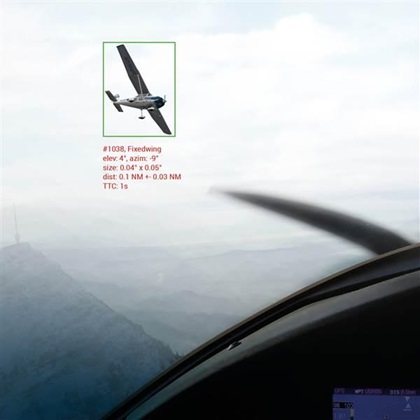Your artificial co-pilot is on the way
Avidyne partners with Swiss aviation AI leader
Cameras and computers programmed to spot traffic and emergency landing fields comprise Avidyne’s PilotEye Vision System, powered by a Swiss-made neural network that aims to be a decision-making asset. That’s the near-term plan, with pricing and availability to be announced.
Avidyne and Daedalean AG, based in Switzerland, announced they are collaborating to certify an artificial assistant for human pilots that has uses other than automating emergency landings. None of the PilotEye capabilities announced July 26 as EAA AirVenture got underway in Oshkosh, Wisconsin, involve actually landing the airplane (much less on any particular color dot). Avidyne explains that PilotEye is being designed to serve as “General Aviation’s first AI-based onboard pilot aid system, and it is the first product from the collaboration between Avidyne and Daedalean.”
The ultimate application of the technology will be full autonomy, but no national aviation authority has yet certified anything like that, and the path to self-flying aircraft runs right through GA. PilotEye will not control the aircraft (at first), but provides a second set of (unblinking) eyes that interpret the world around, continuously assessing emergency landing field options and reporting graphically on their fitness, calling attention to nearby traffic, terrain, and other hazards. It is designed to “provide pilot advisories,” the press release noted.
“Leveraging advanced AI technologies, these solutions will initially include visual-spectrum camera-based systems for visual positioning and traffic detection, hazard avoidance, and landing guidance, as well as providing the data that pilots need for quicker and more-accurate land-anywhere decision-making assistance in the event of emergency,” said Avidyne President Dan Schwinn.

Avidyne will bring its name recognition and GA manufacturing and certification experience to the team effort, and Daedalean will bring the algorithms—as well as no apparent shortage of pluck. In a recent blog post titled “Challenge accepted,” Daedalean founder and CEO Luuk van Dijk compared his product to the computer vision system created by Iris Automation that has been used to enable unmanned aircraft to detect and avoid other airborne objects using onboard equipment. The CEO was responding to video posted by Iris Automation showing more than 300 aerial encounters over 100 minutes of flight, and a message inviting Iris’ company newsletter readers to test their own eyes against Casia, Iris’ detect-and-avoid system. Daedalean engineers ran the same video frames through their own system, posting the object detection statistics (and quite a few videos of their own) on that blog post. (It’s a bit of a nerds-rule rabbit hole, so suffice to say both systems performed well; the standard they will ultimately be held to is not yet defined.)
Daedalean noted that its system is made from more robust, heavier hardware designed for aviation use, and designed to do much more than spot traffic. All that PilotEye appears to lack, in terms of on-board infrastructure to enable autonomous flight, is autopilot integration, but that will be a much bigger hurdle when it comes to persuading risk-averse aviation regulators. Daedalean has been working with European regulators to create a framework for approving such systems.
"Certification of safety-critical AI based systems is a paradigm shift in aviation," said van Dijk, in Avidyne’s July 26 press release. “We are excited to be partnered with Avidyne, who will certify, manufacture, and be the first provider in the aviation market of AI-based safety solutions powered by Daedalean AI software.”
Daedalean’s van Dijk is scheduled to deliver a seminar about aviation automation at EAA AirVenture on July 30 at 10 a.m. at the AOPA Pavilion.




